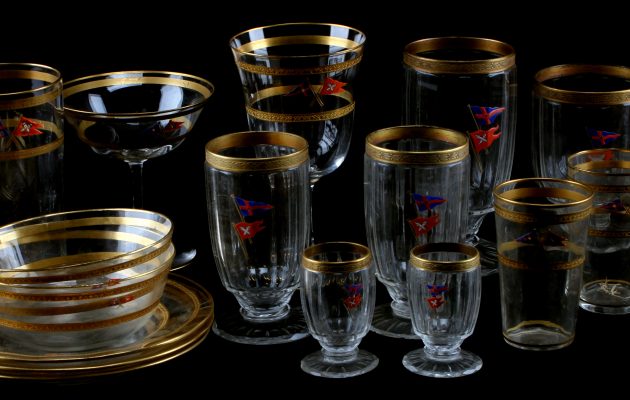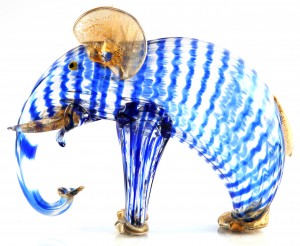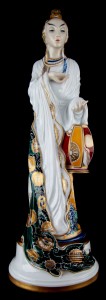Forgotten treasures fund healthier lives

Who would have thought after paying decades worth of storage fees, so many treasures from one of Florida’s wealthiest families would surface and eventually benefit the foundations they created to help those in need?
The Jacksonville-based Alfred I. duPont Foundation had been paying storage bills for a unit in Tallahassee, but it wasn’t until 2013 when its new president, Clay Smallwood, and some Foundation staff decided to find out just what was stored away. They uncovered a treasure trove reminiscent of King Tut’s tomb.
“I asked what we were paying for in storage, and nobody could remember what was in there,” Smallwood said.
On a trip to the storage facility to investigate he discovered numerous boxes full of items from Alfred and Jessie (Ball) duPont’s homes at Epping Forest and at Southwood Plantation in Tallahassee, and from their yacht. A number of rare and valuable items, such as fine china, art glass, even an ivory-handled flyswatter, were numbered among the find.
“We decided the best thing was to monetize it (the find) to give to somebody it would help,” said Smallwood of the numerous high end, and now antique, items.
“We give away money; it’s what Mrs. duPont charged us to do and it’s what we do,” he said, adding it didn’t make sense to spend storage fees when proceeds from these items could help the Alfred I. duPont Foundation.
It will take five to six weeks from the auction’s close in September for a check to arrive at the Foundation, though a final tally is not yet available. Money from the sale of the items will be used to continue their philanthropic causes.
The Foundation distributes grants to endowed scholarships, social causes, Red Cross and Salvation Army chapters, churches in Delaware and Florida, and several homes for disadvantaged children as well as those with autism and special needs, Smallwood said.
Alfred I. duPont, who first made his fortune in the family’s gunpowder business in New England, moved to Florida with wife, Jessie Ball, in 1926. His desire as a Florida resident was simple: “Through helpful works, let us build up good in this state and make it a better place in which to live.”
Though he nearly doubled his wealth while living in Florida, duPont’s viewpoint on wealth was one of stewardship. Many stories have been told of duPont helping those in need, including individuals on the streets and, during the Depression, the unemployed.
“It has been my firm conviction throughout life that it is the duty of everyone in the world to do what is within his power to alleviate human suffering. It is therefore natural that I should desire, after having made provision for the immediate members of my family and others whom I have seen fit to remember, that the remaining portion of my estate should be utilized for charitable need,” stated duPont’s will after his death in 1935.
Trustees Jessie Ball duPont and her brother, Edward Ball, established a foundation to care for crippled children and the elderly. Soon after, the Nemours Foundation and Alfred I. duPont Institute, which provide extensive children’s health outreach programs, came into being. Though they are separate charitable entities from the Alfred I. duPont Foundation, each organization carries on duPont’s mission to provide for those in need.
Providing help to others didn’t mean self-deprivation for the duPonts. Lavish items from the storage facility include a hand-painted, Rosenthal porcelain Chinese dancer figurine designed by Austrian sculptor Constantin Holzer-Defanti; an 88-piece set of New York Yacht Club glassware featuring 22 kt gold rims with NYYC/duPont crossed-flags logo, and an elegant, gold-trimmed porcelain inkwell.
Several of the many items available were realized (sold) significantly above their high estimates, said Laura Hawkins of Affiliated Auctions, which sold many of the items.
A 105-piece, early 20th century set of Hohenberg china, with gold trim and featuring the New York Yacht Club logo, had a high estimate of $800 but realized a winning bid of $4,900.
Also purchased for $4,500, well above its estimated value of $200, was a Murano blown glass elephant from the estate of Edward Ball, brother-in-law of duPont.
Beating its high estimate of $500 was an Alfred I. du Pont monogrammed sterling silver set, which sold for $1,050.
In addition to these items, a number of family photographs were among the duPonts’ belongings. These will be given to the Alfred I. duPont Testamentary Trust for safe keeping and possible display at some future date, Smallwood said.
“It’s incredible the legacy he and his wife left is still ongoing and touches people,” he said, adding that because of the duPonts’ philanthropic foresight the legacy will touch lives in perpetuity.








